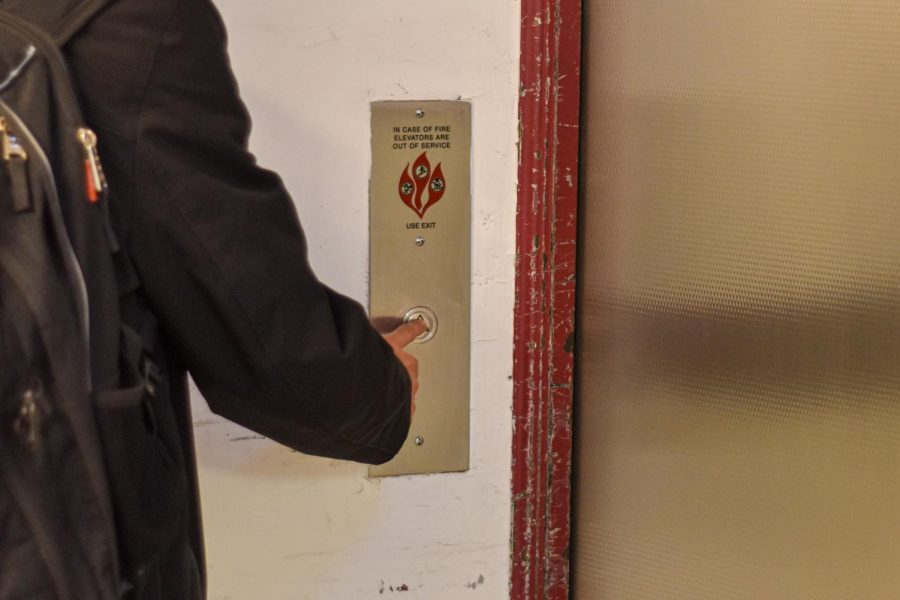Elevator obstacles generate anxiety
Elevator issues such as long wait times and break-downs increase stress in students who need it to get to class.
February 7, 2022
Class began five minutes ago, but Lorelei Deakin is still waiting at the Judd Hall elevator for the car to arrive. As the seconds tick by, the silence of the hallway sets in, and Lorelei grows increasingly anxious about getting to class.
The elevator has still not arrived, and she cannot use the stairs while in her wheelchair, so she starts considering other options to get to class.
Lorelei and other students with physical disabilities or injuries are frustrated about accessibility issues they encounter around Lab, which they say have increased their personal and physical stress.
Lab meets and exceeds ADA guidelines for building accessibility, according to Director of Operations Joe Wachowski, because it follows the higher standards set by the University of Chicago. However, students with disabilities say elevators break down once or twice every two months, inhibiting their ability to easily get around campus and causing them to be late for class.
There is no elevator to the second floor of Sunny Gymnasium, and the Judd fourth floor is available only by elevator or stairs, which makes it inaccessible when an elevator is out of service.
When an elevator is broken, junior Mayu Blume pushes herself to carry her backpack up the stairs, which is not ideal because she worries about further hurting her leg and hip.
Lorelei, a junior, pointed out that some able-bodied students do not follow the elevator policy, which only allows faculty, staff and the students who checked out an elevator key to use an elevator. These extra trips mean that people with needs like her have to wait longer. The elevators can also be slow to call, particularly the Judd elevator.
Lorelei said some ramps at Lab make it difficult for her to control her wheelchair. Some ramps are too long, so it becomes exhausting to use, while others are too short, making her gain too much momentum.
Ninth grader Hana Javed said problems she encountered in middle school using the elevator next to the Kenwood entrance still persist today.
According to Hana, the elevator smelled horrible, due to bits of trash left from transporting garbage, and the elevator key was difficult to acquire.
“It was almost impossible to obtain without really putting up a fight, almost,” Hana said. “You had to prove your injury or disability, and then they still wouldn’t really trust you, so you had to get a doctor’s note — you had to get other permission — and I didn’t really have time to prove it when I had to use it.”
Hana’s experience made her wary of the school’s investment in making improvements to accessibility.
Senior Peter Stern had a broken leg for six weeks last fall and, while on crutches, encountered problems with elevator wait times and fire drill procedures.
During a fire drill in October, Peter could not easily use the stairs, so he waited in a stair landing’s help area and pushed the “press for help” button, but no one came. He said it was concerning to expect someone to come but have nobody show up.
While Peter’s injury meant he encountered these issues for only a short time, he understands the frustration students with disabilities have with accessibility issues.
“I was kind of able to suck it up and not suffer too much, but I could definitely see how, if this was something you had to deal with every day for the entire year, it could be extremely frustrating,” Peter said.
Given the constraints of working within a historic building, there were some limitations to addressing ADA guidelines when the Historic Campus was renovated in 2013-2016.
Mr. Wachowski said additional elevators could not be added during the renovation due to space and funding constraints. The first elevator to need an update will be the middle school elevator, followed by those in Blaine and Judd, but as of 2022, no dates have been set for changes.
Yet, Mr. Wachowski hopes to install an elevator in Sunny Gym in the future and understands the complaints about long elevator wait times. He timed the Judd elevator before and once had to wait up to 12 minutes because there were different elevator queues before his.
Lorelei and Mayu acknowledge that there are issues, but they also appreciate the existing accessibility at Lab, and want to work to improve it. Both would appreciate faster, more responsive elevators.
Recently, Lorelei formed a committee with student groups like Eye to Eye and Students with Scoliosis to address accessibility issues at Lab and foster discussions with administrators.
Mr. Wachowski said that he and senior administration will meet later this month to address some of the issues raised by students with disabilities before the winter break.
“There are changes to be made, but the teachers I’ve been working with and administration members and committee members I’ve been working with are committed to making that change,” Lorelei said. “And if anybody has accessibility concerns, whether it impacts them directly or not, then I encourage them to speak up about it.”




























































